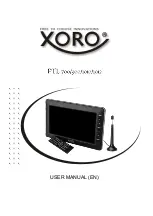
72
Remote Operation
The instrument can be remotely controlled via its RS232 or GPIB interfaces. When using RS232
it can either be the only instrument connected to the controller or it can be part of an addressable
RS232 system which permits up to 32 instruments to be addressed from one RS232 port.
Some of the following sections are general and apply to all 3 modes (single instrument RS232,
addressable RS232 and GPIB); others are clearly only relevant to a particular interface or mode.
It is only necessary to read the general sections plus those specific to the intended remote
control mode.
Remote command format and the remote commands themselves are detailed in the Remote
Commands chapter.
Address and Baud Rate Selection
For successful operation, each instrument connected to the GPIB or addressable RS232 system
must be assigned a unique address and, in the case of addressable RS232, all must be set to
the same Baud rate.
The instrument’s remote address for operation on both the RS232 and GPIB interfaces is set via
the
remote
menu on the UTILITY screen, see System Operations section.
REMOTE:
interface: RS232
◊
address: 05
◊
baud rate: 9600
With
interface
selected with the
interface
soft
−
key, the selection can be toggled
between RS232 and GPIB with alternate presses of the soft
−
key, the cursor keys or by using the
rotary control.
With
address
selected, the soft
−
key, cursor keys or rotary control can be used to set the
address.
With
baud rate
selected, the soft
−
key, cursor keys or rotary control can be used to set the
baud rate for the RS232 interface.
When operating on the GPIB all device operations are performed through a single primary
address; no secondary addressing is used.
NOTE: GPIB address 31 is not allowed by the IEEE 488 standards but it is possible to select it as
an RS232 address.
Remote/Local Operation
At power
−
on the instrument will be in the local state with the REMOTE lamp off. In this state all
keyboard operations are possible. When the instrument is addressed to listen and a command is
received the remote state will be entered and the REMOTE lamp will be turned on. In this state
the keyboard is locked out and remote commands only will be processed. The instrument may be
returned to the local state by pressing the LOCAL key; however, the effect of this action will
remain only until the instrument is addressed again or receives another character from the
interface, when the remote state will once again be entered.
















































